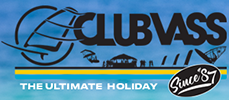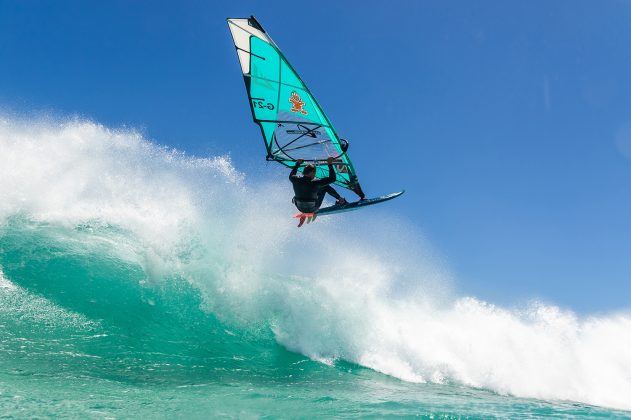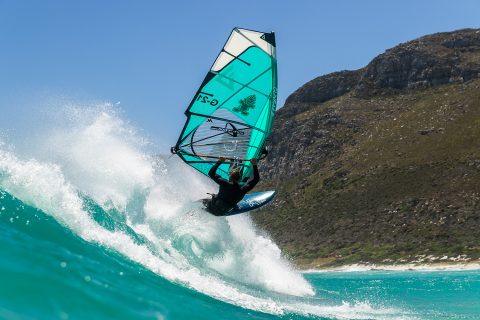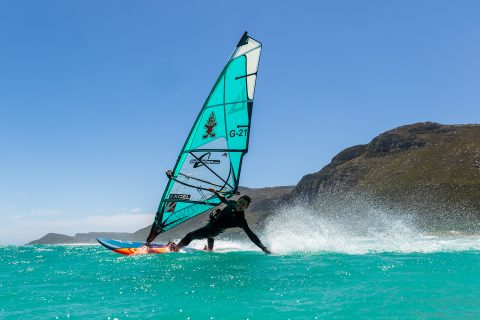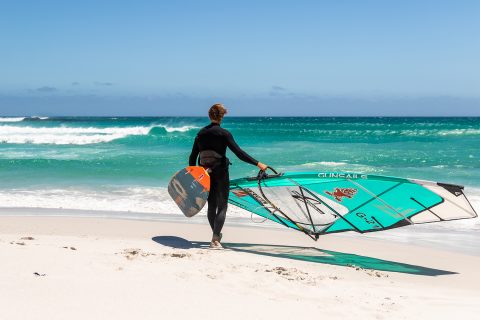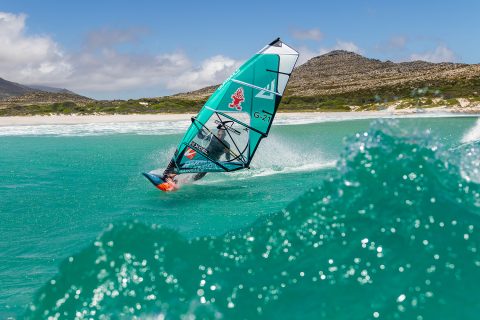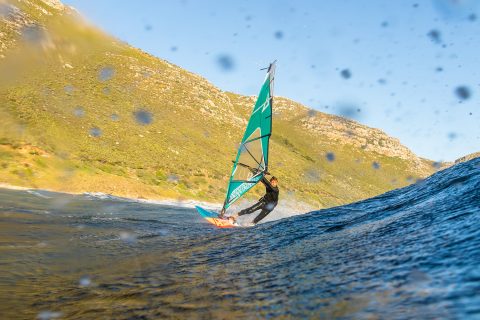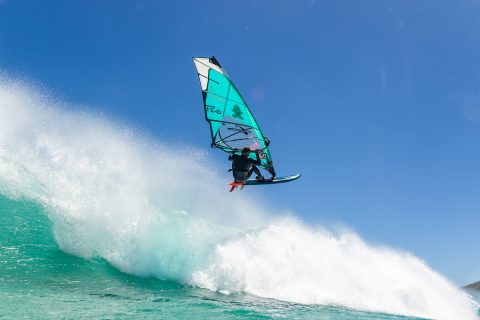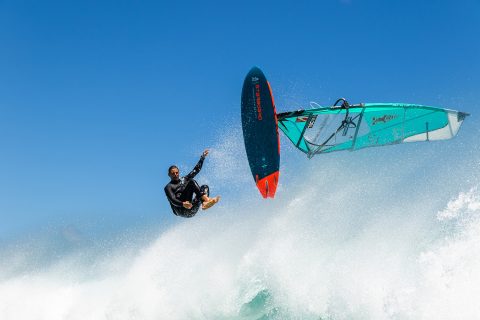FLO JUNG’S WAVE TIPS: FIRST WAVES
Looking to start wave sailing? Flo Jung offers some tips to get you started.
Words – Flo Jung // Photos – Samuel Tomé
What is so fascinating about our sport? Why do we check the weather forecast over and over again. Why do we invest so much effort, and sacrifice a big part of our social lives, just to be out on the ocean for a few hours? Is it the feeling of flying weightless over the water? Is it the hope of riding the perfect wave, for those that are wave addicted?
- Flo Jung Photo – Samuel Tomé
For me every session on the water is a gift, it’s a chance to focus on the moment, on the now. It’s that whole experience, starting with the anticipation of packing my kit into the car, the feeling of pure freedom, the power of the ocean under my feet, the force of the wind in my hands and the rush of adrenaline in my blood.
Compared to other sports you have to invest a lot to learn how to get better in windsurfing, but it is really rewarding when finally things come together and you feel that excitement of pulling a new move, riding a big wave or just having fun with your friends on the water.
- Flo Cruising Photo- Samuel Tomé
But for me the ultimate challenge in windsurfing is riding waves. Because alongside the variable of wind, is the other unpredictable element of waves. And even though it can feel like an eternity to learn how to adapt to them, the journey is really special and I think can give you one of the best feelings in the world. I have dedicated a large part of my life to experiencing this moment again and again. If you have never tried it, I would like to share that stoke with you and hope this wave riding guide might inspire you to work on some new tricks, travel to a new wave destination or just rethink your gear setup.
It’s a learning process that is about gaining experience. You will fail, get up again, get washed and maybe feel out of your comfort zone. With the right preparation and attitude though, you will be ready for this challenge and discover a whole new dimension of windsurfing.
- Heading out: Photo- Samuel Tomé
Preparations
If you want to tackle waves, you have to be well prepared physically to go out into the ‘field’. First of all as prevention for injuries, but also to just have as much time as possible on the water. There is nothing more annoying than coming out of the water after 15 minutes because you are out of breath, or your arms are cramping up. It’s important to pay attention to a strong core, forearms, upper body and lower back to handle worst-case situations like a wipeout. It could also be beneficial to swim regularly and practice holding your breath underwater for at least a minute. Set yourself some defined goals, like doing 30 push-ups every morning, starting a few weeks before your next windsurf trip.
In the terms of board selection, 5-10 litres + body weight is a good guide for volume required. For example, a sailor that weighs 80 kg should have a board with at least 90 litres of volume for starting out in wave sailing. In order to get through the shorebreak, I would also suggest a board that planes early, but still offers good turning abilities.
- Bottom turn Photo – Samuel Tomé
With more experience people tend to have boards with less volume, but I prefer bigger boards. I am 80 kg and the board that I use most is my 86-litre thruster; which I use in basically any kind of conditions. Nowadays most boards turn really good with multi-fin setups, but I also like the feeling of having a bit more volume in the front of the rails, and it’s way easier to get over a wave if you have a bit of volume under your feet.
Another important factor are harness lines, they should rather be too long than too short. This enables you to have the freedom of movement to pump the sail or hook in at any time. Make sure the harness lines are placed at the right spot on the boom. In order to check that, place one hand on the boom and hook in and see at what position the sail feels balanced
In addition, fins greatly extend the range of your board in waves. In onshore conditions I tend to ride bigger fins with less rake, which helps to generate more power. In side-shore conditions, the emphasis is on control and turning, so smaller fins with more flex and rake are preferred. Just to give you an idea, my standard thruster setup for my 86-litre wave board consists of a 17.5 cm centre fin and 11cm side fins.
Footstrap size and position is also a matter of taste, but you should have enough hold during manoeuvres and still be able to get both feet out of the straps at any second during a wipeout. I also like to have a wide stance on my board to be able to shift my weight to the back and front. For reference the distance between straps that I use is the length of my forearm and hand.
Especially in winter, you should take a spare rope with you, which can be stowed on your harness, to repair broken parts temporarily just to get back to shore. If you want to be on the safe side, you can also use buoyancy aids or small inflatable devices like that from Resttube (www.resttube.de) as a buoyancy aid to attach to your harness. This has saved me a couple of times during long swims in cold water.
Wave knowledge
In wave sailing, spots with side or side-offshore conditions are ideal for your first attempts to get some waves. Onshore wind, which often exists in European areas, can make riding, and especially getting out over the waves, much more challenging. Onshore conditions where the wind and waves come from the same direction are not as easy to ride or as clean as side-shore conditions.
Waves often originate hundreds of miles away in storm regions like the North Atlantic. These wave movements continue to run towards the coast even after the storm has already subsided. On their journey through the ocean, a ‘ground swell’ is created. A larger swell has a wave period of about 13 to 20 seconds, smaller swells range from 5 to 12 seconds. The wave period forecast can be checked on websites like windguru.com or windfinder.com. Of course, the wave height at the respective spot also plays a decisive role. A forecast with a 2-metre wave and 16 seconds might be bigger than a forecast of 4-metre waves and 10 seconds at some breaks, but a longer period can mean a bigger gap between the waves to get out.
At each new spot you sail, get yourself familiar with the best tide, best swell direction and possible exit points or hazards like currents or shallow reefs. Observe the area for a while and ask a friendly local for advice. If I sail a spot for the first time, I work out possible exit strategies if something goes wrong. When this is done and I am comfortable with my escape plan, there is nothing to worry about and I can enjoy hitting the lip.
- It is all about the timing: Photo – Samuel Tomé
Reading a wave
Waves usually come in smaller and larger ‘sets’, meaning a sequence of mostly 3-5 waves that are bigger than the average wave size. These are to be avoided when going out while crossing the impact zone (the zone were waves are breaking), but can be of benefit when looking to catch the best wave in the ‘lineup’ (the area where waves start to break).
In order to get a better picture of how the conditions are, it is worth observing the waves from land for 10-15 minutes before you enter the water. Then you can see how often ‘rideable’ waves appear, where the current is flowing and if there are any channels (area, where no or less waves are breaking) that can help you get past the impact zone.
On the water, it also helps to set landmarks on the coast, such as trees or a building, so you can orientate yourself as to where to start riding the wave.
Finding waves
The multi-million dollar question is now, how do you find the best wave on the water before they start to break. The answer is simple, you have to wait for them. Like surfers that sit in the lineup waiting, you can learn how to hover on your windsurfer. It’s like pressing the pause button! To do so, open your sail, stall your board into the wind and keep balancing while going nowhere. The best place to do that is to wait patiently in an area behind the impact zone, which can usually be recognized by the white foam line of recently broken waves. For a comfortable waiting position, go out of your footstraps and place your front foot in front of the mastbase. Open your sail to where you still feel a bit of pressure. Keep looking behind you and scan the horizon for approaching waves. In the beginning these waves all look the same and it’s hard to see them, but with patience you will see slightly bigger set waves once in a while. In order to catch them, close the sail just before the wave comes your way and get enough speed up to get on the wave face.
If the right wave or set wave doesn’t show up, turn around and go out again, sail a bit upwind and repeat the waiting game behind the impact zone.
With more experience you will already see the building swell or walls of water while going out and can quickly tack or jibe on to them. It’s usually the best choice to let the first wave of the set go through. This way you avoid the risk of being washed by 2 or 3 consecutive bigger waves that will follow. Furthermore, the first wave of a set is also much more disordered (choppy) than the following waves.
Don’t make the mistake to rush for a wave that starts to build up in front of you. If you come over the back of the wave, you could easily overlook surfers and it also becomes more difficult to read the waves and to position yourself accordingly.
In the beginning, bigger waves are easier to ride, because you can see how the wave builds up. Look around you to get an overview where other people are catching waves and learn to observe how the spot changes with the tide, get in the mindset where you are constantly thinking about your next move.
Once you feel the push of the wave, the board will start to accelerate. That’s the moment when you sometimes might put your weight on the tail of the board to slow it down while the wave builds, as you don’t want to rush down the face and go too early before the wave has evolved into a steep wall.
Wave timing
Wave riding is all about timing, and it’s better to be too early than too late and get smashed by the lip. Another wise quote says, “Hit the lip or the lip will hit you.” So your timing is a delicate balance to get right.
If you do decide to take a wave, do it with 100% commitment. If you hesitate or have doubts, you are most likely to get your timing wrong or find yourself in worst-case situations, like being sideways to a breaking wave.
The trick is to switch off your brain for a moment and use your intuition. Focus on the moment; be peaceful and relaxed like doing a normal jibe. The best moment to really go for the bottom turn is a crucial decision and varies according to wave size and speed. Stay high on the shoulder of the wave and look through the sail to see how the wave slowly starts to build up downwind of you. At the last moment, just before the wave starts to break, go into the bottom turn, dropping with full speed from the highest point of the wave. Remember, speed is always your friend when riding a wave. The faster you are, the more freedom you have to adapt to the wave, presuming that speed comes along with control. As a beginner, it’s easier to start riding the wave a little earlier and then slowly adjust the timing to what feels comfortable. In order to boost your confidence it also helps to really get yourself worked by a small wave on purpose. After a few controlled wipeouts you know how to handle the situation and that there is nothing to worry about. That takes away the stress and anxiety. It’s important to create a situation where you learn within your own boundaries step by step.
Wipeouts
Sometimes things don’t always go smoothly on the road to success. Wipeouts are simply a part of wave riding and something you have to accept when playing with these forces of nature. When you learnt how to walk, you fell a few hundred times as well. Luckily, as windsurfers we usually fall into water and after a spin of a few seconds in the big ‘washing machine’, it is all over. Before a wave pushes you under, try to take a deep breath, protect your head with your arms and then just relax – this way you use less oxygen. Try to release tension in every part of your body and slowly count from 1 to 10. After a few seconds you will resurface. Now your mission is to get back to your gear as quickly as possible. Orientate yourself to where your stuff is, especially your board! It should never be between you and an approaching wave. Even if something is broken, stay with your gear at all times. It’s your life insurance and a floating object that you can use to paddle back to shore.
If you get caught in a current, never swim against it. A current always goes in circles so it can be useful to swim sideways, parallel to the beach, out of the current. In all critical situations out on the ocean, it’s always important that you don’t panic, stay calm and think.
- Flo Air: Photo – Samuel Tomé
How to ride a wave
Besides getting to the point of safely navigating through the shorebreak, your most important move for riding waves is doing a bottom turn followed by a cutback.
There are a few key points to get the right technique dialled. The good thing is that you can start small and move slowly in ‘S-curves’ down the wave to get a feeling for the power of the wave. A combination of speed and timing are probably your most valuable ingredients to successfully riding waves.
The best conditions to properly learn how to do that are side-offshore conditions.
Let’s say you have found a wave that is slowly building up behind you. Your board builds up speed from the push of the wave and you decide to go for your bottom turn.
These 3 essential movements should be your focus:
- Your head controls your body movements. Look in the direction where you want to go/surf. Aim for the lip of the wave and just before doing the cutback look over your shoulder to initiate the cutback.
- Hold your boom as wide as possible in the bottom turn and lean forward by keeping the front arm extended. Bend your knees and dig the whole rail of your board in the water by putting weight on your toes. Carve up the face and maintain speed by putting weight forward.
- Before you hit the lip, initiate the change of direction by sliding your back hand to the front of the boom and look over your shoulder down to the bottom of the wave. Lean on your heals and carve with the tail of the board back into the pocket of the wave.
All these movements happen quite simultaneously, so it’s good to get them mentally sorted in your mind before trying them on the water.
It’s a really rewarding feeling when your timing is right and everything comes together.
In this moment you feel the energy of the ocean full power with speed that is mainly generated by the wave. You can draw your own personal line in a liquid blue wall before it finally disappears.
Dealing with fear
- The fear factor: Photo – Samuel Tomé
Wave riding is kind of a cat-and-mouse game. It is about chasing waves and hoping that the wave doesn’t chase you. It’s a thin line between euphoria and fear. Situations can arise in which you are overstrained and reach your own limits. Fear is an emotion, just like anger or joy, and often arises when something is foreign to us or we do not understand it. The difference is how these emotions affect us. Fear can limit our abilities (panic) or it can be an important warning signal for us. In this case I try to understand what is happening around me that triggers this feeling. You can always control your breathing and if you focus on deep inhales and exhales into your belly you will start to feel calm and relaxed.
Life is the most precious thing we have, therefore it is also wrong to let fear paralyse us or to neglect our spirit of adventure. The best things in life are often on the other side of maximum fear. So, face your fears and activate your greatest growth. Whether riding Jaws in Hawaii or a day with small waves on the North Sea, every ride in the waves is unique and offers endless possibilities. From good preparation comes self-confidence and only through self-confidence can you achieve your greatest achievements in life and sport. So enjoy the process, from seemingly never ending learning to one of the best feelings in the world.

